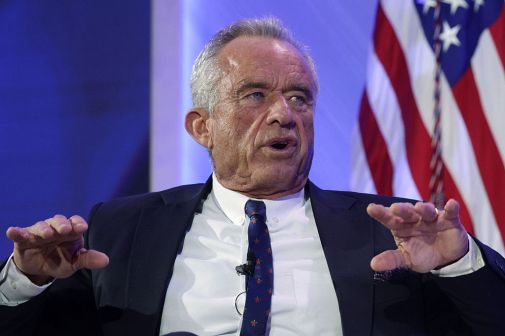Health and Human Services Secretary Kathleen Sebelius announced six winners in the HHSinnovates program Friday in a ceremony at HHS headquarters. The winners included three “Secretary’s Picks” and three honorable mentions.
“The HHSinnovates program celebrates inventive new ideas to help carry out the mission of the department,” Sebelius said. “We have tapped into a culture of collaboration, creativity and innovation that encourages out of the box thinking to improve our service to Americans.”
Winners from HHS:
Electronic Patient Tracking in Disasters – To help hospitals manage high volumes of incoming patients in disaster situations, the National Library of Medicine (NLM) at the National Institutes of Health (NIH) worked collaboratively with leading hospitals in Bethesda, Maryland to develop a Patient Tracking and Locating System that can be made available to hospitals nationwide. Through its novel use of technology, this system empowers hospital emergency management staff with real-time information about incoming patient counts, severity status, and location, assuring key decision makers have the information necessary to make timely decisions critical to patient care. It is an exportable model that can be easily deployed and tailored to work in any hospital setting. Key Contributors: Ivor D’Souza, Wei Ma, Cindy Notobartolo, Laura Lee, Chandra Kola, David Zhang, and Dwight Clarke
Connecting Kids with Dental Care – Drawing on the web’s popular “store locator” formats, the Health Resources and Services Administration (HRSA) and the Centers for Medicare & Medicaid Services (CMS) formed a partnership with over 150 state agencies and managed care organizations to create an easy-to-use online search tool for finding dental providers who serve children from low-income families. The Insure Kids Now Dental Provider Locator is designed to enable mostly-automatic updating from existing data sources, greatly reducing the costs of upkeep while ensuring current information. Key Contributors: Terri Lynn Cohen, Nancy Goetschius, James Resnick, Sanjoy Chakraborty, Keith Adams, and Barbara Gandy
Preparing for the Zombie Apocalypse – The Centers for Disease Control and Prevention (CDC) stepped far outside the normal government communications box with a social media campaign that used humor and popular culture to convey basic messages about disaster preparedness. Using the CDC blog, Public Health Matters, a small team of employees crafted a witty but educational blog post about zombie preparedness, while regularly referring to real emergencies like hurricanes, floods, or earthquakes. Communicators stated that if people were prepared for a zombie apocalypse they were prepared for any emergency. Readers were told how to make an emergency plan and kit as well as how to stay informed. When the campaign went viral, its messages reached millions of viewers, and personal knowledge about preparing for disasters was enormously increased – for an initial investment of only $87. Key Contributors: Dave Daigle, Margaret Silver, Ali Khan, and Catherine Jamal
The other three innovations receiving recognition at the ceremony included:
Million Hearts™ Initiative – is a national initiative to prevent one million heart attacks and strokes in America over five years. As a result of the initiative, multiple agencies at HHS joined together to create a uniform set of measures to monitor clinical performance and implement interventions based on four key evidence-based prevention strategies (appropriate use of aspirin, blood pressure control, cholesterol management, and smoking cessation) and have aligned incentives for clinicians and health systems to achieve high performance. Through the use of meaningful incentives, HHS has effectively engaged public and privates partners to adopt the initiative’s approach and interventions and to assist in raising awareness of cardiovascular disease by utilizing new media technologies. In its first six months, this novel approach has resulted in more than 35 public and private stakeholder organizations working together to deliver aligned and focused prevention strategies. Key Contributors: Michael Schooley, Peter Briss, James Galloway, Judy Hannan, Joseph McCannon, Farzad Mostashari, and Janet Wright
Leveraging the Public to Catch Fugitives – As part of a broad upgrade of its communications activities, the HHS Office of Inspector General (OIG) created the first federal website focused solely on accused criminals wanted for health care fraud. The OIG’s Most Wanted Healthcare Fugitives website leverages the power of the public and social media in catching and punishing criminals. OIG special agents, even with the help of other federal law enforcement partners, cannot be on every U.S. street corner, so tips are essential. In the initiative’s first year, 10 fugitives were captured and held responsible for stealing millions of dollars. An international fugitive even turned himself in after discovering himself on the Most Wanted list. Key Contributors: Roberta Baskin, Erin Fuchs, and Jessica Long
Bridging the CHASM of Health Disparities – Through an innovative outreach program, the U.S. Public Health Service Commissioned Corps greatly leveraged its own resources and those of other federal, state and local agencies to improve public health services to Americans. In its Community Health and Service Missions (CHASM) program, the Corps draws on its unique position under the leadership of the Surgeon General to assemble broad federal and state resources and target them in a highly cost-effective way to help local agencies improve their public health assessment, analysis, and interventions. Key Contributors: CAPT Kimberly Elenberg, CAPT Carol Lincoln, MaryAnn Veitch, CAPT Calvin Edwards, CAPT Alan Parham, CDR Christopher McGee, and CDR David Morrissette






